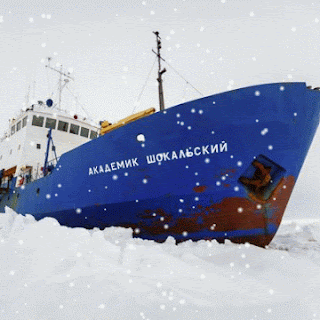MOSCOW, December 30 (RIA Novosti) – All passengers and four crew members aboard a Russian research ship stuck in the ice off the coast of Antarctica will soon be evacuated by a Chinese helicopter, the Russian Foreign Ministry said Monday.
“A decision has been made to evacuate 52 passengers and four crew members by a helicopter from China’s Xuelong icebreaker, if weather conditions are suitable,” the ministry said.
Eighteen crew members are expected to remain aboard the icebound ship, the Akademik Shokalsky.
A team of scientists and tourists on the ship had been retracing a famous Australian Antarctic Expedition from 101 years ago when the vessel became trapped in thick ice about a week ago.
A Chinese icebreaker, the Snow Dragon, came within just seven nautical miles (11 kilometers) of the stranded vessel on Saturday, but was forced to turn back after also having problems with dense ice. An earlier rescue attempt by a French vessel had also failed.
An Australian icebreaker, the Aurora Australis, was forced to turn back from a rescue attempt earlier on Monday, citing poor weather that made the mission unsafe.ria.ru
30/12/13
--
-
Related:
Принято решение об эвакуации 52 пассажиров и 4 членов экипажа вертолетом китайского корабля «Сюэлонг», если это позволят погодные условия.
Посольство России в Австралии поддерживает постоянную связь с властями страны пребывания и капитаном НИС «Академик Шокальский» И.Б.Киселевым. По его информации, все члены экипажа и другие участники экспедиции здоровы. Угрозы для их жизни и безопасности нет.
http://www.mid.ru/brp_4.nsf/newsline/322E3A1B389B7D9244257C51004978D8
30/12/13
“A decision has been made to evacuate 52 passengers and four crew members by a helicopter from China’s Xuelong icebreaker, if weather conditions are suitable,” the ministry said.
Eighteen crew members are expected to remain aboard the icebound ship, the Akademik Shokalsky.
A team of scientists and tourists on the ship had been retracing a famous Australian Antarctic Expedition from 101 years ago when the vessel became trapped in thick ice about a week ago.
A Chinese icebreaker, the Snow Dragon, came within just seven nautical miles (11 kilometers) of the stranded vessel on Saturday, but was forced to turn back after also having problems with dense ice. An earlier rescue attempt by a French vessel had also failed.
An Australian icebreaker, the Aurora Australis, was forced to turn back from a rescue attempt earlier on Monday, citing poor weather that made the mission unsafe.ria.ru
30/12/13
--
-
Related:
Antarctic mission now pinning hopes on Australian icebreaker for rescue. -VIDEO. L'Akademik Shokalskiy toujours prisonnier des glaces
China’s Snow Dragon to aid rescue of trapped Russian ship...
Icebound Antarctic passengers face air rescue if ship cannot reach them soon...
Les passagers piégés dans l'Antarctique seront évacués par hélicoptère...
------
Antarctic expedition scientists trapped in ice....
--------------------
- СООБЩЕНИЕ ДЛЯ СМИ О ситуации с НИС «Академик Шокальский».....
Принято решение об эвакуации 52 пассажиров и 4 членов экипажа вертолетом китайского корабля «Сюэлонг», если это позволят погодные условия.
Посольство России в Австралии поддерживает постоянную связь с властями страны пребывания и капитаном НИС «Академик Шокальский» И.Б.Киселевым. По его информации, все члены экипажа и другие участники экспедиции здоровы. Угрозы для их жизни и безопасности нет.
http://www.mid.ru/brp_4.nsf/newsline/322E3A1B389B7D9244257C51004978D8
30/12/13






 GR
GR FR
FR DE
DE ES
ES IT
IT RU
RU EU
EU